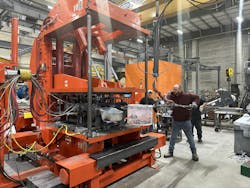Fix Manufacturing Extension Programs, Don't Defund Them (Op-Ed)
My last meeting of the day on Good Friday was with a group of government employees and civic volunteers. Not an unusual occurrence. If anything, this has been my consistent experience with public service: a group of overworked and underpaid people who take their work seriously and reflexively put the mission above themselves.
We had just received word that federal funding for the Manufacturing Extension Partnership (MEP) program had been abruptly eliminated, and then just as abruptly restored. This was more than just bureaucratic turbulence. Something bigger was at play.
At the precise moment when reshoring American manufacturing has become a central plank of the President’s economic agenda, funding is being cut for one of the few programs that actually helps manufacturers compete globally.
The MEP, created during the Reagan administration to help small and mid-sized manufacturers improve productivity amid the rising threat of Japanese manufacturing, is not a household name. But across the country, it has quietly supported the small businesses that make up the heart of our industrial base.
Let’s be honest. The program has become inefficient. In Wisconsin, the administrative structure is a legacy of a workaround to federal rules, patched together to keep good people and institutions in the game. I chair the board of the Wisconsin Center for Manufacturing and Productivity (WCMP), which oversees two MEP affiliates: the Wisconsin Manufacturing Extension Partnership (WMEP) and the Manufacturing Outreach Center (MOC) at UW-Stout. If that confuses you, you’re right.
The result is a structure with too many people managing the process and not enough delivering services. That needs to be fixed. The recent scare has given us the urgency to do just that.
This is what is roiling the nation: cost-cutting meets real public needs. In this case, it’s a bloated program that still does essential work. The right answer is not to end it. It’s to fix it.
At Wisconsin Aluminum Foundry, we know the value of these agencies firsthand. We worked with WCMP to expand exports of our All American 1930 consumer products line, bringing our pressure cookers and sterilizers to new international markets. We also participated in WCMP’s Automation Advisor program to guide our investment in robotics. They helped us make smart capital decisions and improve operational efficiency.
Another company where I serve on the board in Sheboygan has used WCMP to reduce energy waste. And WCMP has supported broader innovation initiatives, including placing an engineer at the UW-Milwaukee Connected Systems Institute in partnership with TitletownTech to explore how artificial intelligence can improve manufacturing processes. These are the kinds of projects that move small manufacturers forward.
This matters, because the task ahead is enormous. Just last week, one of our customers, a Florida company that makes power systems for data centers, began moving sourcing from Canada to the U.S. due to the Trump Administration’s steel and aluminum tariffs. But the Canadian supplier was still beating us on cost. Wages and inputs were similar. What they had was greater efficiency.
That moment was a wake-up call. The tariff helped bring business back, but now it’s on us to become competitive. This is when we turn to WCMP for help. As a small manufacturer, we rely on outside expertise to help us solve big problems, especially if new technologies are required. If we don’t act, our inefficiency simply becomes someone else’s inflation.
That’s why Wisconsin’s continued support matters. The Wisconsin Economic Development Corp continues to support WMEP’s and MOC’s critical work. This is a meaningful vote of confidence from a state that knows manufacturing. We don’t have the resources of the federal government, but we’re spending what we can on this work because we’ve seen the impact. And so have our manufacturers.
The MEP has bipartisan support. It has the backing of small businesses. And it is doing what policymakers say they want: helping American industry grow, compete, and modernize.
We should keep the pressure on to make the program leaner. But we also need to keep funding it. Let’s roll up our sleeves and work together to save something worth saving. And maybe – just maybe – this could be a model for how to reduce federal spending smartly, not destructively. By fixing what’s broken, and preserving what works.
About the Author

Sachin Shivaram
Sachin Shivaram is CEO of Wisconsin Aluminum Foundry (WAFCO), a company founded in 1909 that now has five facilities in Wisconsin, Indiana and Minnesota. He is also chairman of the board of the Wisconsin Center for Manufacturing and Productivity, one of two Manfuacturing Extension Partnerships in the state.
